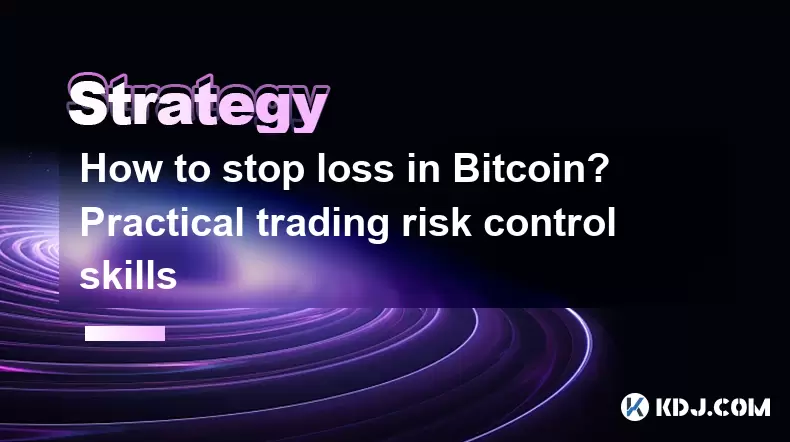-
 bitcoin
bitcoin $122288.232522 USD
0.16% -
 ethereum
ethereum $4480.662914 USD
-0.22% -
 xrp
xrp $2.962747 USD
-2.32% -
 tether
tether $1.000120 USD
-0.05% -
 bnb
bnb $1145.654223 USD
-2.07% -
 solana
solana $227.105217 USD
-1.67% -
 usd-coin
usd-coin $0.999548 USD
-0.02% -
 dogecoin
dogecoin $0.250875 USD
-2.04% -
 tron
tron $0.340654 USD
-0.49% -
 cardano
cardano $0.837968 USD
-2.52% -
 hyperliquid
hyperliquid $48.960449 USD
0.06% -
 chainlink
chainlink $22.049280 USD
-1.33% -
 ethena-usde
ethena-usde $1.000404 USD
0.02% -
 sui
sui $3.586212 USD
0.20% -
 avalanche
avalanche $29.894916 USD
-4.18%
How to stop loss in Bitcoin? Practical trading risk control skills
Stop loss orders are essential for managing risk in Bitcoin trading, helping to limit losses by automatically closing positions at predetermined price levels.
May 13, 2025 at 05:36 am

Introduction to Stop Loss in Bitcoin Trading
Stop loss is a crucial risk management tool used by traders to limit potential losses in their trading activities. In the volatile world of Bitcoin, where prices can swing dramatically within short periods, implementing effective stop loss strategies is essential to protect your investment. This article will explore practical trading risk control skills that can help you manage your Bitcoin positions effectively.
Understanding Stop Loss Orders
A stop loss order is an order placed with a broker to buy or sell a security when it reaches a certain price. For Bitcoin traders, this means setting a predetermined level at which your position will be automatically closed to prevent further losses. Understanding the different types of stop loss orders can help you choose the most suitable one for your trading strategy.
- Standard Stop Loss: This is the most common type, where the order is triggered when the market price reaches the specified stop price.
- Trailing Stop Loss: This type adjusts the stop price at a fixed percentage or dollar amount below the market price as it moves in your favor, allowing you to lock in profits while still protecting against a downturn.
- Guaranteed Stop Loss: Offered by some brokers, this ensures that your position will be closed at the exact stop price, regardless of market gaps or slippage.
Setting Up a Stop Loss Order on a Bitcoin Exchange
To set up a stop loss order on a Bitcoin exchange, follow these steps:
- Log into your trading account on the exchange platform.
- Navigate to the trading interface where you can place orders.
- Select the Bitcoin pair you are trading, such as BTC/USD.
- Choose the type of order as a stop loss order.
- Enter the stop price at which you want the order to be triggered.
- Set the quantity of Bitcoin you want the order to cover.
- Review and confirm the order details before submitting it.
Determining the Right Stop Loss Level
Choosing the right stop loss level is critical to balancing risk and reward. Here are some factors to consider when setting your stop loss:
- Volatility: Bitcoin's price can be highly volatile, so consider using technical indicators like the Average True Range (ATR) to gauge market volatility and set your stop loss accordingly.
- Support and Resistance Levels: Identify key support and resistance levels on the price chart and place your stop loss just below a support level or above a resistance level to avoid being stopped out prematurely.
- Risk Tolerance: Your personal risk tolerance should guide your stop loss placement. If you are more risk-averse, you might set a tighter stop loss, while a higher risk tolerance might allow for a wider stop loss to give your trade more room to breathe.
Implementing a Trailing Stop Loss
A trailing stop loss can be an effective way to protect profits while allowing your position to continue benefiting from favorable price movements. Here's how to implement a trailing stop loss:
- Determine the trailing amount: Decide on a fixed percentage or dollar amount that you want the stop loss to trail behind the market price.
- Set the initial stop loss: Place the initial stop loss at a level that reflects your risk tolerance and market conditions.
- Monitor and adjust: As the market price moves in your favor, the trailing stop loss will automatically adjust to lock in profits. If the price reverses and hits the trailing stop, your position will be closed.
Combining Stop Loss with Other Risk Management Techniques
While stop loss orders are a vital part of risk management, they should be used in conjunction with other techniques to create a comprehensive risk management strategy. Consider the following:
- Position Sizing: Determine the size of your Bitcoin position based on your overall portfolio and risk tolerance. Smaller position sizes can reduce the impact of potential losses.
- Diversification: Spread your investments across different cryptocurrencies and asset classes to mitigate risk.
- Regular Monitoring: Keep an eye on market conditions and adjust your stop loss orders as needed to reflect changes in volatility and price trends.
Psychological Aspects of Using Stop Loss Orders
The psychological aspect of trading can significantly impact your ability to use stop loss orders effectively. Here are some tips to manage the emotional side of trading:
- Stick to Your Plan: Develop a trading plan that includes clear rules for setting and adjusting stop loss orders, and adhere to it regardless of emotional impulses.
- Accept Losses: Understand that losses are a part of trading and that stop loss orders are there to protect your capital. Accepting small losses can prevent larger ones.
- Avoid Overtrading: Frequent trading can lead to emotional exhaustion and poor decision-making. Use stop loss orders to manage your trades and avoid the temptation to overtrade.
Frequently Asked Questions
Q: Can I use stop loss orders on all Bitcoin exchanges?A: Not all Bitcoin exchanges offer stop loss orders. It's important to check the features of your chosen exchange and consider using one that supports this functionality if it's a key part of your trading strategy.
Q: How often should I adjust my stop loss orders?A: The frequency of adjusting stop loss orders depends on your trading strategy and market conditions. Some traders adjust their stop losses daily, while others may do so weekly or based on significant price movements.
Q: What should I do if my stop loss order is triggered?A: If your stop loss order is triggered, review your trading plan and assess whether the market conditions have changed. You may decide to re-enter the trade at a more favorable price or move on to another opportunity.
Q: Can stop loss orders guarantee that I won't lose money?A: No, stop loss orders cannot guarantee that you won't lose money. Market gaps or slippage can result in your order being executed at a worse price than intended. However, they are an effective tool for managing risk and limiting potential losses.
Disclaimer:info@kdj.com
The information provided is not trading advice. kdj.com does not assume any responsibility for any investments made based on the information provided in this article. Cryptocurrencies are highly volatile and it is highly recommended that you invest with caution after thorough research!
If you believe that the content used on this website infringes your copyright, please contact us immediately (info@kdj.com) and we will delete it promptly.
- BlockDAG, DOGE, HYPE Sponsorship: Crypto Trends Shaping 2025
- 2025-10-01 00:25:13
- Deutsche Börse and Circle: A StableCoin Adoption Powerhouse in Europe
- 2025-10-01 00:25:13
- BlockDAG's Presale Buzz: Is It the Crypto to Watch in October 2025?
- 2025-10-01 00:30:13
- Bitcoin, Crypto, and IQ: When Genius Meets Digital Gold?
- 2025-10-01 00:30:13
- Stablecoins, American Innovation, and Wallet Tokens: The Next Frontier
- 2025-10-01 00:35:12
- NBU, Coins, and Crypto in Ukraine: A New Yorker's Take
- 2025-10-01 00:45:14
Related knowledge

Practical parameter settings for a Bitcoin multi-timeframe moving average system
Sep 18,2025 at 10:54pm
Optimizing Timeframe Combinations for Bitcoin Trading1. Selecting appropriate timeframes is crucial when building a multi-timeframe moving average sys...

How can I filter out false breakouts in Dogecoin high-frequency trading?
Sep 22,2025 at 01:00am
Understanding False Breakouts in Dogecoin Trading1. A false breakout occurs when Dogecoin's price appears to move beyond a defined support or resistan...

Techniques for identifying tops and bottoms in the Bitcoin on-chain NVT model
Sep 20,2025 at 07:54pm
Understanding the NVT Model in Bitcoin Analysis1. The Network Value to Transactions (NVT) ratio is often described as the 'P/E ratio' of the cryptocur...

What does the surge in open interest in Bitcoincoin futures mean?
Sep 20,2025 at 11:18pm
Understanding the Surge in Dogecoin Futures Open Interest1. A surge in open interest within Dogecoin futures indicates a growing number of active cont...

How can I use the Ethereum USDT premium to gauge market sentiment?
Sep 18,2025 at 11:55pm
Understanding the Ethereum USDT Premium1. The Ethereum USDT premium refers to the price difference between USDT (Tether) traded on Ethereum-based plat...

What should I do if Ethereum staking yields decline?
Sep 20,2025 at 06:18am
Understanding the Causes Behind Declining Ethereum Staking Yields1. The Ethereum network transitioned to a proof-of-stake consensus mechanism with the...

Practical parameter settings for a Bitcoin multi-timeframe moving average system
Sep 18,2025 at 10:54pm
Optimizing Timeframe Combinations for Bitcoin Trading1. Selecting appropriate timeframes is crucial when building a multi-timeframe moving average sys...

How can I filter out false breakouts in Dogecoin high-frequency trading?
Sep 22,2025 at 01:00am
Understanding False Breakouts in Dogecoin Trading1. A false breakout occurs when Dogecoin's price appears to move beyond a defined support or resistan...

Techniques for identifying tops and bottoms in the Bitcoin on-chain NVT model
Sep 20,2025 at 07:54pm
Understanding the NVT Model in Bitcoin Analysis1. The Network Value to Transactions (NVT) ratio is often described as the 'P/E ratio' of the cryptocur...

What does the surge in open interest in Bitcoincoin futures mean?
Sep 20,2025 at 11:18pm
Understanding the Surge in Dogecoin Futures Open Interest1. A surge in open interest within Dogecoin futures indicates a growing number of active cont...

How can I use the Ethereum USDT premium to gauge market sentiment?
Sep 18,2025 at 11:55pm
Understanding the Ethereum USDT Premium1. The Ethereum USDT premium refers to the price difference between USDT (Tether) traded on Ethereum-based plat...

What should I do if Ethereum staking yields decline?
Sep 20,2025 at 06:18am
Understanding the Causes Behind Declining Ethereum Staking Yields1. The Ethereum network transitioned to a proof-of-stake consensus mechanism with the...
See all articles










































































